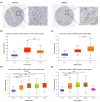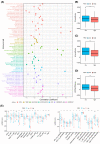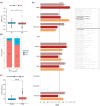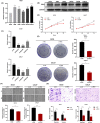PES1 is a biomarker of head and neck squamous cell carcinoma and is associated with the tumor microenvironment
- PMID: 37076985
- PMCID: PMC10278488
- DOI: 10.1002/cam4.5948
PES1 is a biomarker of head and neck squamous cell carcinoma and is associated with the tumor microenvironment
Abstract
Background: As a nucleolar protein associated with ribosome biogenesis in multiple cancer types, PES1 has been reported to be overexpressed, promoting cancer cell proliferation and invasion. However, in head and neck squamous cell carcinoma (HNSCC), the role of PES1 on the prognosis and immune infiltration remains unknown.
Methods: Multiple databases and qRT-PCR evaluated the expression of PES1 in HNSCC. The prognostic potential of PES1 in HNSCC patients was analyzed by Cox regression and Kaplan-Meier curves. Then, we used LASSO regression and stepwise multivariate Cox regression to construct the PES1-related risk assessment model. In addition, the association between PES1 and tumor immune microenvironment and drug sensitivity was explored by R packages. Finally, we used cell function assays to explore in HNSCC if PES1 influences tumor growth and metastasis.
Results: PES1 was significantly up-regulated in HNSCC and closely correlated with HPV status, tumor stage, clinical grade, and TP53 mutation status. Survival analysis suggested that PES1 is associated with worse survival outcomes, acting as an independent prognostic indicator for HNSCC. Our model also performed well in terms of prognosis prediction. Furthermore, tumor-infiltrating immune cells and antitumor drug susceptibility were negatively related to PES1 expression. Functionally, as for HNSCC cell lines in vitro, the knockdown of PES1 could inhibit proliferation, migration, and invasion.
Conclusion: We have demonstrated that PES1 may be a promoter of tumor growth. PES1 holds excellent promise as a novel biomarker to assess the prognosis of patients with HNSCC and may guide immunotherapy.
Keywords: PES1; TCGA; head and neck squamous cell carcinoma; immune infiltration; prognosis.
© 2023 The Authors. Cancer Medicine published by John Wiley & Sons Ltd.
Conflict of interest statement
The authors declare no competing interests.
Figures








Similar articles
-
Pescadillo ribosomal biogenesis factor 1 reduction suppresses tumour growth and renders chemosensitivity of head and neck squamous cell carcinoma.Cancer Med. 2023 Mar;12(5):5703-5717. doi: 10.1002/cam4.5315. Epub 2022 Oct 11. Cancer Med. 2023. PMID: 36217758 Free PMC article.
-
TYK2 correlates with immune infiltration: A prognostic marker for head and neck squamous cell carcinoma.Front Genet. 2022 Dec 1;13:1081519. doi: 10.3389/fgene.2022.1081519. eCollection 2022. Front Genet. 2022. PMID: 36531252 Free PMC article.
-
FAM3D as a Prognostic Indicator of Head and Neck Squamous Cell Carcinoma Is Associated with Immune Infiltration.Comput Math Methods Med. 2022 Dec 3;2022:5851755. doi: 10.1155/2022/5851755. eCollection 2022. Comput Math Methods Med. 2022. PMID: 36510584 Free PMC article.
-
Development and experimental verification of a prognosis model for disulfidptosis-associated genes in HNSCC.Medicine (Baltimore). 2024 Mar 22;103(12):e37308. doi: 10.1097/MD.0000000000037308. Medicine (Baltimore). 2024. PMID: 38518012 Free PMC article. Review.
-
Targeting Epigenetic Dysregulations in Head and Neck Squamous Cell Carcinoma.J Dent Res. 2025 Mar;104(3):225-234. doi: 10.1177/00220345241297122. Epub 2024 Dec 19. J Dent Res. 2025. PMID: 39698794 Review.
Cited by
-
Exploring the Therapeutic Implications of Co-Targeting the EGFR and Spindle Assembly Checkpoint Pathways in Oral Cancer.Pharmaceutics. 2024 Sep 11;16(9):1196. doi: 10.3390/pharmaceutics16091196. Pharmaceutics. 2024. PMID: 39339232 Free PMC article. Review.
-
Bioinformatics-based analysis of nicotinamide adenine dinucleotide metabolism-related genes to predict immune status and prognosis for head and neck squamous cell carcinoma patients.Front Immunol. 2025 Jun 30;16:1609175. doi: 10.3389/fimmu.2025.1609175. eCollection 2025. Front Immunol. 2025. PMID: 40661938 Free PMC article.
-
Analysis and Validation of Autophagy-Related Gene Biomarkers and Immune Cell Infiltration Characteristic in Bronchopulmonary Dysplasia by Integrating Bioinformatics and Machine Learning.J Inflamm Res. 2025 Jan 13;18:549-563. doi: 10.2147/JIR.S495132. eCollection 2025. J Inflamm Res. 2025. PMID: 39839185 Free PMC article.
-
Pescadillo ribosomal biogenesis factor 1 and programmed death-ligand 1 in gastric and head and neck squamous cell carcinoma.World J Gastroenterol. 2025 May 21;31(19):106644. doi: 10.3748/wjg.v31.i19.106644. World J Gastroenterol. 2025. PMID: 40497089 Free PMC article.
-
Prognostic Value of the Immunohistochemical Detection of Cellular Components of the Tumor Microenvironment in Oral Squamous Cell Carcinoma: A Systematic Review.Curr Issues Mol Biol. 2025 Jul 12;47(7):544. doi: 10.3390/cimb47070544. Curr Issues Mol Biol. 2025. PMID: 40729013 Free PMC article. Review.
References
-
- Pfister DG, Spencer S, Adelstein D, et al. Head and neck cancers, version 2.2020, NCCN clinical practice guidelines in oncology. J Natl Compr Canc Netw. 2020;18(7):873‐898. - PubMed
-
- Chow L. Head and neck cancer. N Engl J Med. 2020;382(1):60‐72. - PubMed
-
- Sung H, Ferlay J, Siegel RL, et al. Global cancer statistics 2020: GLOBOCAN estimates of incidence and mortality worldwide for 36 cancers in 185 countries. CA Cancer J Clin. 2021;71(3):209‐249. - PubMed
-
- Mcdermott JD, Bowles DW. Epidemiology of head and neck squamous cell carcinomas: impact on staging and prevention strategies. Curr Treat Options Oncol. 2019;20(5):43. - PubMed
Publication types
MeSH terms
Substances
LinkOut - more resources
Full Text Sources
Medical
Molecular Biology Databases
Research Materials
Miscellaneous

